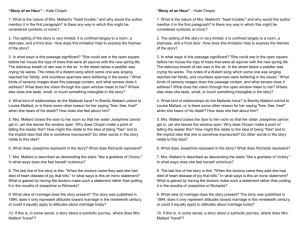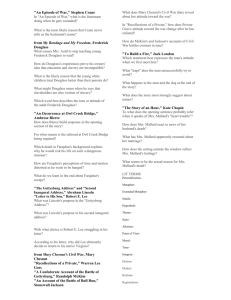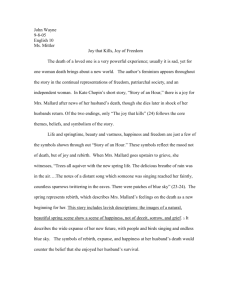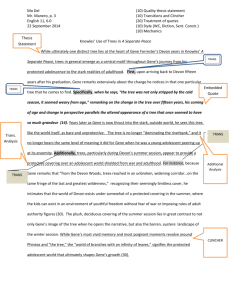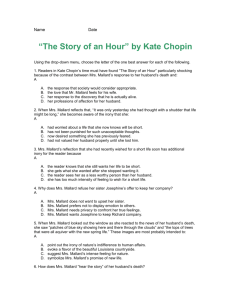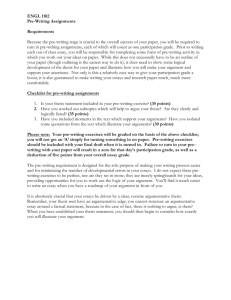Diagnostic essays
advertisement
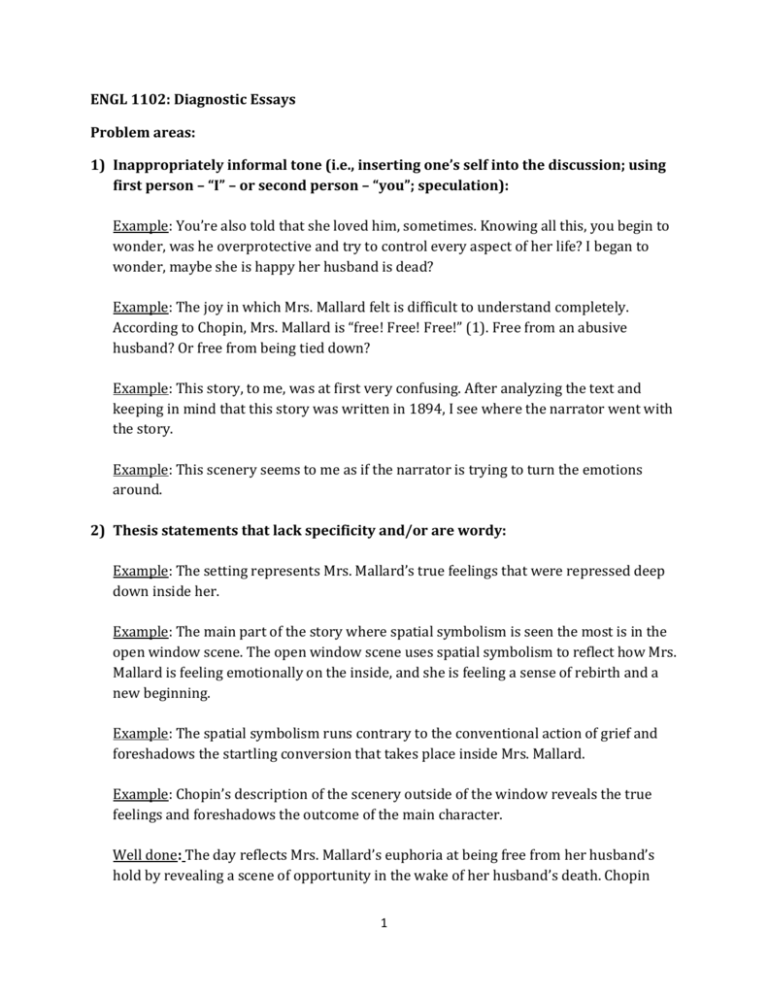
ENGL 1102: Diagnostic Essays Problem areas: 1) Inappropriately informal tone (i.e., inserting one’s self into the discussion; using first person – “I” – or second person – “you”; speculation): Example: You’re also told that she loved him, sometimes. Knowing all this, you begin to wonder, was he overprotective and try to control every aspect of her life? I began to wonder, maybe she is happy her husband is dead? Example: The joy in which Mrs. Mallard felt is difficult to understand completely. According to Chopin, Mrs. Mallard is “free! Free! Free!” (1). Free from an abusive husband? Or free from being tied down? Example: This story, to me, was at first very confusing. After analyzing the text and keeping in mind that this story was written in 1894, I see where the narrator went with the story. Example: This scenery seems to me as if the narrator is trying to turn the emotions around. 2) Thesis statements that lack specificity and/or are wordy: Example: The setting represents Mrs. Mallard’s true feelings that were repressed deep down inside her. Example: The main part of the story where spatial symbolism is seen the most is in the open window scene. The open window scene uses spatial symbolism to reflect how Mrs. Mallard is feeling emotionally on the inside, and she is feeling a sense of rebirth and a new beginning. Example: The spatial symbolism runs contrary to the conventional action of grief and foreshadows the startling conversion that takes place inside Mrs. Mallard. Example: Chopin’s description of the scenery outside of the window reveals the true feelings and foreshadows the outcome of the main character. Well done: The day reflects Mrs. Mallard’s euphoria at being free from her husband’s hold by revealing a scene of opportunity in the wake of her husband’s death. Chopin 1 chooses a quiet spring day instead of a gloomy rainy one to represent the sense of happiness instead of sadness in Mrs. Mallard. 3) Basing argument on generalizations: Example: The comfortable, roomy armchair isn’t exactly what most women would go for right after their husband’s death. Example: Normally, any person that has lost someone close to them prefers to be comforted and surrounded by others. Perhaps this indicates that Mrs. Mallard was already seeking her newfound freedom. Well done: The open window itself stands for Mrs. Mallard’s feelings of freedom from the oppressive bounds of wedlock. Well done: Ironically, outside the window she saw and sensed springtime weather. Spring often brings a feeling of renewal and rebirth. Well done: The view outside symbolizes that this is the end of one chapter, a chapter that was filled with oppression, and the start of a new chapter, a chapter of freedom and new life. Well done: The new spring life that has Mrs. Mallard’s attention symbolizes her mood, suggesting that she is ready for a new start; spring is the time of new birth and growth. 4) Topic sentences that lack specificity: Example: The scenery described by Chopin was almost foreshadowing her next reaction. Example: In the open window scene, spatial symbolism is used throughout to foreshadow freedom. Example: The setting outside the window is a clue to what Mrs. Mallard’s emotions switch to. Well done: Louise Mallard identifies the scene outside her window as a promise of freedom. 2 Well done: The imagery in the scene outside Mrs. Mallard’s window resonates with a sense of hope. Well done: Chopin uses spring as a metaphor to symbolize Mrs. Mallard’s rebirth. 5) Slipping into plot summary with no analysis: Example: From the beginning she had an awkward way of dealing with the news of her husband’s death. She cried, but wanted nothing to do with her sister. All she wanted was to be left alone. While she was off to herself, she was looking out the window, admiring the growth of the trees and beautiful spring life. 6) Making broad, general statements and/or stating the obvious: Example: There are many mixed signals that could be easily viewed differently, but if really examined, meaning can be found. Example: Utilizing symbols to illustrate literature in a story can invest precise meaning towards the important characters, major settings, and situations. Example: There are many times throughout the story when the author uses other ways of creating understanding. Well done: The “tops of trees [ . . . ] delicious breath of rain [ . . . ] notes of a distant song [ . . . ] patches of blue sky [and] countless sparrows” (77) all work to convey the message of life, resurrection, and cleansing. 7) Unnecessary references to the reader and/or audience: Example: The story contains multiple examples of symbolism, which the author uses to direct the reader’s view of the death of Mrs. Mallard’s husband. Example: The atmosphere of spring is pure and refreshing, which is the transition point of how the reader should view the situation. The author also tells the reader that “there were patches of blue sky” (76). 8) Wordy, awkward, or inexact constructions: 3 Example: The sentence, “The notes of a distant song which someone was singing reached her faintly” foreshadows the end of the story. (Avoid “interrupting” sentences with quotes, as this leads to awkward constructions.) Example: Chopin describes the scenery in the room as an almost freedom-like feeling. Example: The scene that Mrs. Mallard saw looking out of the open window was a scene that reflects Mrs. Mallard’s emotional state and how she was feeling after she found out about her husband’s death that she was a woman on her own and no longer a wife. Example: In “The Story of an Hour,” the main character Mrs. Mallard experiences the tragedy of her husband only to find out that he never really died, which ironically possibly could’ve been the source that unexpected killed her. Example: The open window scene uses spatial symbolism to reflect how Mrs. Mallard is feeling emotionally on the inside. 4 Other reminders: Literary present tense MLA style/formatting Proofreading aloud A Writer’s Resource codes and abbreviations; end note with corresponding numbers Where to go from here 5
